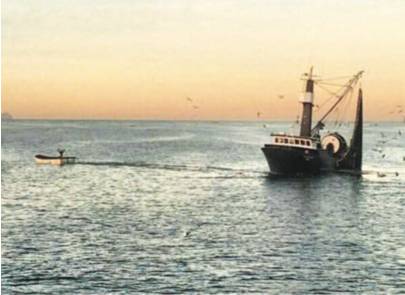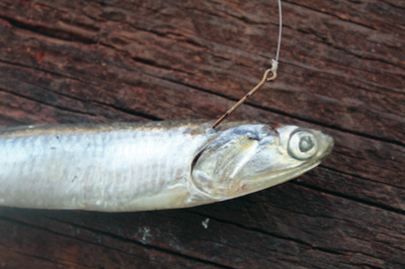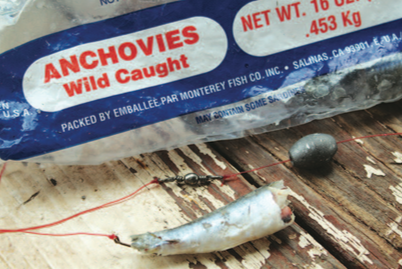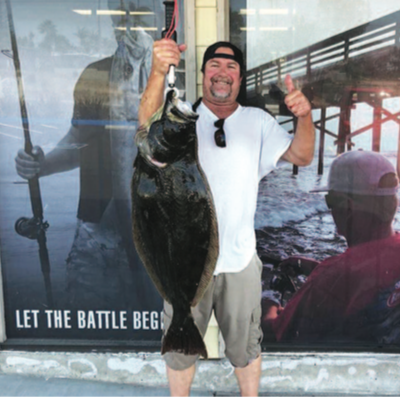BY GUNDY GUNDERSON
SAN DIEGO – I know I’m pushing it when I raise the fishing of an anchovy to an art form. But not by much. When fished properly in the right spot, at the right time, it is one of the most versatile and effective natural baits in Southern California saltwater fishing. It is also the top striped bass bait in the fresh waters of the Colorado River. The diminutive baitfish will take a wide variety of species. It requires little more than an ice chest to transport and stow. It can be fished in many different sizes from whole to small chunks to tipping a Sabiki. It is the most popular bait among shore fisherman and tackle shops both on the beaches and on the Colorado River. These shops literally sell tons of these diminutive frozen fish each and every year.
Targeted species
The beauty of the anchovy is that nearly every species will eat it. The small baitfish is one of the chief forage fish along the Southern California bight. Coastal anglers can expect to catch many different species. On the beaches, and in the bays and lagoons, the halibut is probably the most targeted species. A halibut will eat a fresh frozen anchovy nearly as well as a live one. On the reefs, kelp stringers and off the jetties and piers, calico bass and sand bass will readily take the frozen bait.
On the open beaches, the long rodders casting outside the breakers target yellowfin croaker, white seabass, striped bass and the occasional spotfin croaker with frozen chunks. In the breakers, barred perch will crush a 1-inch piece. Even sharks, leopard, smoothound, shovelnose and bat ray will take the bait. Smaller species on structure like cabezon, johnnie bass, chocolate rockfish, sargo, rubber lip and 7-11 perch readily take smaller chunks, too. It is an incomplete list as there are a probably a few more species neglected. But generally, you are not going to find a better all-around bait.
The bottom line is that when you are soaking an anchovy anywhere along the Southern California coast, you stand a chance at catching more than a dozen different fish. It has a versatility ideal for the inshore fisherman. When you go into a spot blind, prospecting, starting with a frozen anchovy is always a good move. You can find bites involving several different gamefish.

The bait storage
Procuring anchovies is easy. Most seaside or Colorado River tackle shops carry plenty of the bait. You want to buy them from a shop that moves plenty of bait. This way you have new supplies of fresher bait. Old bait turns yellowish or will appear freezer burned with lots of frost in the bag. Look at a few bags and make sure you are getting the cleanest, freshest looking bait available.
Storing the bait is the key to being consistently successful when fishing anchovy. The small baitfish is very delicate. Once defrosted, it quickly losses its firmness and strength. If it warms, it turns to a mushy consistency and is nearly impossible to keep on the hook, both by cast and by fish ripping it off. Keeping the anchovies as close to frozen-hard as possible is the goal. You can put a hook through a harder frozen piece and it will stay on the hook when you cast it. And it will hold on the hook firmly for several minutes in the water before softening.
The best way to store frozen anchovy is in a bait-dedicated cooler. A small, six-pack size cooler is ideal for a single bag. You don’t want to put the bait with other food and drink because the constant opening of the cooler will defrost the bait. Use blue ice blocks to surround the bait in the cooler. This way the bait does not soak in ice water. Only open the cooler when you need to and don’t leave the lid open. If you follow this protocol, then you can keep your bait hard for a whole fishing session.
It seems like a small thing but it is a big difference maker. By fishing a firm bait, you will make longer casts. Your bait will be fishing longer in the zone. And you will spend much less time retrieving and re-baiting. When shore fishing, the longer time you can deploy your bait in the feeding zone the better your chances of hooking a fish.

Baiting up
Now that we have our bait secured, how are we going to fish it? Of course, the species targeted will inform the bait size. The bait can be fished whole for larger species or sharks. Many halibut anglers will use a whole fish in hopes of targeting a larger fish. Calico bass, sand bass, white seabass, striped bass and sharks will also take a whole fish. The bait is usually hooked just behind the head, or through the tail section. Either way, you have to go around the spine to insure the bait will not tear off the hook when casting. Some folks hook the whole bait through the tip of the nose. When the fish are light biting, a trap rig may improve your hook-up ratio. Another reason to go whole is when the junk fish are stealing your smaller presentations. A big bait will keep the smaller fish off.
The second length and probably the most used size for versatility is a half fish. You’ll target the same species as with the whole piece, maybe adding a few croaker, cabezon or sargo. Simply cut the fish in half with a sharp bait knife as a dull knife will squash the bait – both the head end and the tail end, fish alike. Some prefer the tail, others, the head. It’s all about your experience. I may have a small preference for a tail section when fishing halibut, but that’s about it. The key to hooking a half piece is to get the hook around the small spine of the anchovy. With a hard, frozen bait, push the hook in and rotate it around the spine. This is the strongest part of the bait and will hold the hook best. After baiting the hook, tug on it lightly. If it begins to tear then you have missed the spine.
The next size would be a quarter-fish size bait. This smaller bait is well suited for the welterweights like yellowfin croaker, spotfin croaker, sargo, shallow water rockfish, calico bass, sand bass, spotted bay bass or barred perch. Again, the key when hooking the bait is first to have the right size hook for the size bait you are using and the species you are targeting. Second, make sure the hook goes around the spine. It is especially important with smaller pieces. Once more, it is important to keep the bait frozen to ensure it stays firmly on the hook, as a soft piece here easily tears off the hook. The last size is also the smallest smallest. These pieces are ideal for targeting bantam species like smelt, mackerel, salema, rubberlip, 7-11 and a variety of other perches. Since the hook size is small, make sure you at least get through the skin. This will hold in most cases. It’s important to know how to target these species as many make excellent live bait for more desired inshore species. The small pieces also work well on a Sabiki. When the baitfish won’t take the clean hook, adding a small piece of anchovy will greatly increase your chance of getting a bite, but again, make sure you go through the skin.
The cast
This is an important piece of the puzzle. When fishing an anchovy, you have to make a softer cast. Nothing too hard or too jerky – a nice even release. Think of it like casting an anchovy on a party boat. Leave a rods length of line out, starting vertical dip the rod backward and swing the bait from down, up, around and over the top in a smooth, medium-speed motion. At the top, release the line so you have a nice ark to the cast. Nothing quick or whipping or you will lose the bait. Watch your cast carefully to make sure the bait stays on the hook until it reaches the water. Over time, you will develop a motion that will maximize your distance without losing the bait.
Rigs
There are many ways to fish an anchovy. Specific rigs are dictated by the species pursued and the habitat fished. It’s safe to say the most popular rig is a sliding egg sinker rig. It is versatile and highly effective. Dropper loop or reverse dropper loop rigs are the next most popular. Hook designs are also a function of species and habitat. Bait holder hooks are the most used. The small barbs help hold the bait and the long shank works well with most species. Mosquito-style hooks work well with smaller chunks. Whatever hooks you choose to go with, be sure to keep them sharp.

If you are an inshore fisherman, overlook the frozen anchovy at your own peril. It is one of the best baits in Southern California coastal waters. It is readily available, easy to stow and versatile in its presentation. But most importantly, frozen anchovy is a highly effective bait that will take a wide array of species in many different habitats under many different conditions. Acquiring the skill to fish the small baitfish will broaden your fish catching capabilities and make you a better inshore angler.




